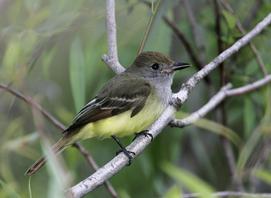GREAT CRESTED FLYCATCHER KS-173
Quivira National Wildlife Refuge, Stafford, Kansas
June 4, 5:26 a.m.
Sunrise at 6:11 a.m.
Three flycatchers in a row sing from the trees beside the education center at Quivira. In the background are two kingbirds, the eastern and western, and here is the great crested flycatcher in full dawn song.
I stand nearby, the parabola aimed at him, and I pick off each sound from his bill. I had expected the quiet, low-frequency raspy note, and I hear it first at one second. Although I had expected him to alternate two different wheeee-up songs, as most great crested flycatchers seem to do, I hear three different ones, at 0:02, 0:05, and 0:07; the first seems a bit laid back, the second a little more emphatic and urgent, the third higher and more strident.
Get a feeling for these three forms of the wheeee-up song and you'll hear them throughout this five minute selection. Or at least that's what I initially thought. Some quick measurements of the wheeee-up songs from this male's singing revealed that he does not have three discrete songs at all. Instead, he varies almost everything you can imagine in each song, such as duration, emphasis, amplitude, tonality, and more, to create an infinite variety of wheeee-up songs. Even if you had the fine ears of a great crested flycatcher, you'd never quite know what is coming next!
That's undoubtedly the nature of the great crested flycatchers everywhere at dawn. Our ears just aren't good enough to realize what they're doing.
Background
Western kingbird especially, and an eastern kingbird a little more distant; Baltimore oriole at 2:24 with long chatter followed by song; mourning dove, cattle.

Photo by John Van de Graaff
